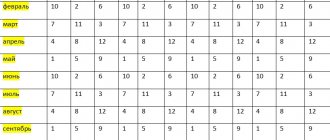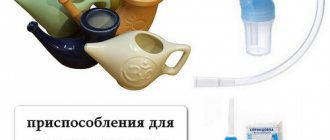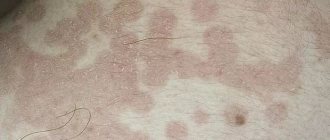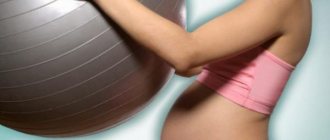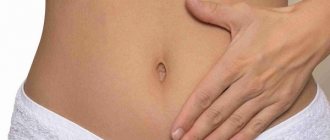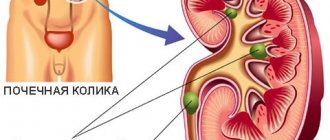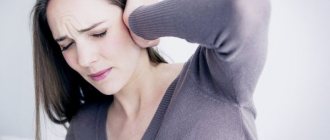I haven't had a runny nose for several days now. This worries me a lot, because I’m pregnant and I don’t want to take any medications. Tell me, is it possible to warm up the nose during pregnancy?
Warming the nasal passages is an effective way to treat a runny nose during pregnancy. To eliminate cold symptoms, you can use a saline bag. Heat the salt in a frying pan, pour it into a cotton bag and apply it to the nose. Such warming improves the outflow of mucus, as a result of which congestion in the nasal passages is eliminated. You can also use saline solutions to treat a runny nose during pregnancy. It is a safe and effective treatment for bacterial or viral colds. The salt is dissolved in boiled water in a ratio of 1:10 and the nose is washed with the resulting medicine several times a day.
Another fairly effective method of treating colds in pregnant women is warming the nose with a hard-boiled egg. This thermal procedure allows you to dilate the vessels of the nasal mucosa, resulting in the release of mucus and clearing the airways from congestion. The heated egg is applied to the area of the bridge of the nose and wings of the nose until the heat remains. However, it is worth noting that such procedures cannot be carried out at elevated body temperatures. It is also not recommended to use hot foot baths or visit a sauna or bathhouse to treat colds during pregnancy. These procedures can provoke premature birth or cause other serious pathologies in the development of the fetus.
In general, a runny nose during pregnancy occurs quite often and does not always indicate the development of colds. Due to hormonal changes, nasal congestion can cause an allergic reaction. Therefore, before using thermal procedures to treat a runny nose, it is better for the expectant mother to consult with her doctor. If the doctor reveals the presence of a viral or bacterial infection in the nose, then home therapy in the form of warming the nose with salt or egg will be effective and necessary for you.
When carrying a child, a woman's body's resistance to bacteria and viruses decreases. Therefore, pregnancy and rhinitis often become companions. In this situation, you need to carefully choose treatment methods so as not to harm the fetus. As a remedy for this condition, it is often recommended to warm the nasal cavity. How effective is this during pregnancy? Is it safe to warm the nose during a runny nose for pregnant women? Doctors allow some thermal procedures, but they must be performed correctly and only in the initial phase of the disease. Let's consider methods of heating, contraindications and alternative methods of treating congestion.
Is it permissible to warm up with eggs and salt during pregnancy?
Warming up is an effective remedy for a runny nose. Salt is often used to treat rhinitis. It is calcined, placed in a linen bag, and then applied to the sinuses and forehead.
Many women are wary of this procedure. Whether it is possible to warm your nose with an egg or salt during pregnancy, your doctor will tell you. The specialist will assess the situation and prescribe the optimal therapy.
Important: rhinitis can be caused by hormonal imbalance or allergies. Therefore, if warming does not produce results, you need to contact an otolaryngologist.
Effective remedies for a runny nose include:
- boiled potatoes in their jackets;
- soft-boiled egg;
- propolis;
- salt;
- buckwheat.
Warming with an egg is recommended to reduce swelling and secretion, restore breathing and smell. The effect of the procedures is achieved through:
- Normalization of respiratory function.
- Acceleration of reparation processes.
- Reducing swelling and reducing blood stagnation.
- Activation of blood flow.
- Improvements to exchange processes.
- Vasodilation.
Important: if, during warming up, severe pain occurs in the nasal area, a migraine appears, the condition worsens, or the temperature rises, you should urgently visit a doctor.
Thermal impact on the nose with salt is necessary for:
- complete or partial loss of taste and smell;
- mucous rhinorrhea;
- nasal congestion;
- sneezing.
After hypothermia, warming up can be used as a preventative measure.
Benefits of the procedure
The effect is achieved through:
- Relieving congestion and facilitating breathing.
- Reducing the amount of mucus produced.
- Acceleration of regeneration processes.
- Reducing swelling.
- Eliminate stagnation in blood vessels.
- Activation of blood flow in the nasal area.
Vapors from calcined salt have pronounced bactericidal properties, which helps not only to warm the nose area, but also to remove pathogenic microbes. It is better to carry out the procedure in the evening. It helps normalize sleep.
Despite the harmlessness of the procedure, it has a number of contraindications.
Heat can cause the opposite effect: excessive mucus production and rapid proliferation of pathogenic microorganisms.
If there is a significant accumulation of pus in the nasal sinuses, a significant increase in discomfort and fever may occur.
If the inflammatory process occurs with a significant accumulation of purulent masses, elevated temperatures increase the risk of the pathogenic process spreading to surrounding healthy areas. In this case, abscesses in the brain tissue, development of frontal sinusitis and otitis media are possible.
Warming the nose with salt during pregnancy is prohibited if:
- malignant or benign neoplasms;
- acute bacterial inflammation;
- increased body temperature;
- complicated rhinitis;
- acute tonsillitis;
- purulent runny nose;
- severe heart or vascular diseases;
- chronic sinusitis.
Contraindications
Is it possible to warm your nose with a blue lamp when you have a runny nose? The answer to this question cannot be unambiguous. It all depends on the etiology of the runny nose (rhinitis), that is, a disease that is manifested by nasal congestion and nasal secretion. The lamp eases the course of colds, but it cannot be used in the following cases:
- Purulent sinusitis.
- Acute purulent inflammation in the area near the nasal cavity.
- Suspicion of a neoplasm.
- Increased blood pressure.
- Severe fever.
- Bleeding.
Purulent inflammation is an absolute contraindication for heating.
Sinusitis of any localization (in particular, sinusitis) is usually provoked by bacterial agents and is characterized by the presence of pus in the paranasal sinuses. Heat exposure is strictly prohibited. Instead of relieving the condition, the patient may face serious complications that are life-threatening.
Heat should not be used if there is a severe fever.
In the acute phase of the inflammatory process, when body temperature is significantly elevated, any warming procedures are prohibited. This is worth remembering when treating a patient of any age. During a fever, the body strives to “shed” excess heat; you should not artificially increase body temperature, even locally.
Warming up the nose during pregnancy
Experts recommend applying heat to the nasal sinuses only in the first days of the disease, when the symptoms of the disease are not yet clearly pronounced. It is also unacceptable to use heating in case of pronounced purulent discharge . Otherwise, the therapy will cause the infection to spread.
Important: to prevent the development of the disease, it is forbidden to stay in a cold room after the procedures.
Using an egg to treat a runny nose has a number of features:
- Before the procedure, you need to thoroughly clean the nasal cavity of any mucus that has accumulated in it. Low concentration saline solutions are well suited for this. You can either purchase them at a pharmacy or prepare them yourself. It’s easy to make a solution at home: dissolve a teaspoon of sea salt in half a liter of warm water.
- Boil the egg. Once it is ready, wipe dry and wrap in cotton cloth. Then the egg is applied to the forehead between the eyebrows and near the nasal area.
If discomfort occurs, you need to wrap the egg in another layer of fabric. After warming up, the skin will remain red. It can be lubricated with baby cream.
Is it possible to warm your nose with salt during pregnancy? If there are no contraindications to the procedure, then it will only benefit the pregnant woman. Basic requirements for warming up:
- Take a small amount of salt, it is better if it is sea salt. Pour it into the frying pan and stir occasionally while heating. After cracking occurs, the salt is removed and poured into a bag. It is necessary to prepare it in advance from dense natural fabric.
- First, the forehead area between the eyebrows is heated, then the left and right sides of the nose.
- If discomfort occurs, the bag can be wrapped in another layer of cloth or wrapped in a towel.
- Warming is carried out for 16 minutes three times a day.
You can increase the effect of the procedure using some simple steps:
- After warming up, you need to drink tea with rose hips or raspberries . This will enhance the effect on the area of inflammation.
- Put warm socks on your feet and lie in bed . It's best to sleep for a while.
- In addition to warming up, you can use honey or aloe juice to drop into your nose . However, before using them, consultation with a doctor is required.
Important: at high temperatures, the use of warming procedures is strictly prohibited!
Beurer IL 30 infrared lamp - review
salvation from chronic sinusitis (photo of application)
And in fact, I turned on the timer for 4-5 minutes, cat. will automatically turn off after the set time has elapsed, turn your nose up and warm up! Only you have to cover your eyes with spoons - because... It is forbidden to look at the light!
On the plus side, the lamp has 4 levels of tilt, making it convenient to set the position.
After the procedure, I feel like after the beach) - and after several sessions, I noticed that the sinus discharge and nose stopped running. I’m very pleased - I use it before bed and go to bed “warm”. Another plus - blackheads and inflammation go away! The effect of the lamp is caused by a rush of blood to the heated area and an increase in metabolism. That's how it works - a lamp!
Contraindications
As sinusitis progresses, the excretory ducts connecting the cavities with the nasal passages become blocked. As a result, discharge accumulates inside the sinuses, which turns into pus when infected. All this makes breathing difficult, creates pain and discomfort.
Neighboring the sinuses are the meninges, eyeballs, and ears, so heating the purulent accumulation in the maxillary sinuses is fraught with especially serious complications. These consequences include:
- Intracranial complications (meningitis, abscess).
- Orbital phlegmon (inflammation of the eye tissue).
- Fistula.
- Inflammation of the periosteum.
- Otitis.
Warming is permissible only at the initial stage of the disease; if a large amount of pus accumulates, such treatment is strictly contraindicated.
The patient himself cannot always determine the stage of development of inflammation in the sinuses, so any heat treatment for sinusitis should be carried out only after consulting a doctor.
How to warm it up?
It is dry heat that is used in the treatment of inflammatory processes. Procedures should be carried out no more than 2 times a day for 10 minutes for 7-10 days. Hygroscopic, easily accessible objects, bulk materials, and special devices are used as heat carriers at home. It can be:
- Salt or sand.
- Egg.
- Blue lamp (Minin reflector).
After completing any of the listed thermal effects, experts recommend stopping walking for 2-3 hours so as not to get hypothermic. The therapeutic effect usually becomes noticeable after 3-4 warm-ups.
Table salt is often used for thermal effects. It is always present in every home, absorbs moisture well, and heats up easily. For the procedure, just heat it in a frying pan and place it inside a cotton bag or sock made of natural material. And even if the temperature of the coolant is too high, it is enough to place a product made of hygroscopic fabric (linen towel) between the bag and the body. Excess moisture will be absorbed by the material, the skin will not be burned, and heat will penetrate deep into the body. Salt can be replaced with sand or fine grains.
One of the most popular, fast-acting methods of warming up sinusitis is using a boiled chicken egg. You should not peel it, just cool it slightly to a temperature of 42 degrees. The procedure can be carried out in one of the following ways:
- Take one egg (not cooled after cooking), alternately apply on both sides at the bridge of the nose.
- Boil 2 eggs and place them on both sides of the nose.
- Roll the egg gently, without pressing, clockwise from side to side. In this case, the impact will be carried out over the entire projection area of the maxillary sinuses.
Warming continues until the egg cools down. The method is considered the most gentle and useful. It is better to throw away the egg after this procedure.
Blue lamp
For warming up, using a blue lamp is effective. This method was proposed by the Russian doctor Minin. It was he who began to use an ordinary incandescent blue glass lamp placed in a mirror reflective hemisphere for medicinal purposes. The advantages of such heating are:
- Large lamp exposure surface. This method allows you to warm up not only the maxillary sinuses, but also other paranasal sinuses (ethmoidal, frontal).
- Collects and concentrates rays on a specific area of the body.
- Thanks to the blue bulb, the thermal radiation emitted by the lamp warms the skin well, penetrating deep into the tissue.
- The light of such a lamp does not harm vision or irritate the eyes.
For thermal effects, the lamp must be plugged in and brought to the desired area at a distance of 20-25 cm at a slight angle. It is better to start warming up from 5 minutes, bringing the time to the required 10-15 minutes.
Application of a reflector
Minin's lamp is known in everyday life as the “blue lamp”. This is a small reflector with a handle. A 60 W incandescent lamp is screwed into it. Minin reflectors use lamps with blue glass, which is where the popular name for this device comes from. You can also use regular flint glass lamps. But the blue light is preferable. It has a less bright light. It reduces the heating of the skin surface, but warms up the sinuses more actively.
The light rays of the reflector should be directed towards the nose. No pre-treatment of the leather is required. In order not to burn the retina, it is necessary to protect your eyes with thick fabric folded in several layers or small sunglasses. The duration of the procedure for an adult is 20 minutes. You can carry out 4 procedures per day.
For a small child, the warm-up time is reduced to 5 minutes. Sessions can be carried out during sleep. In this case, the eyes should be covered with a diaper. The warm-up temperature is checked by hand. If your hand is hot, the device should be taken a greater distance from the patient’s face.
